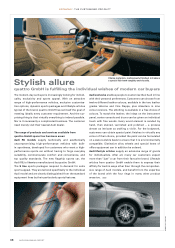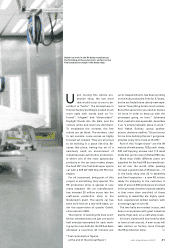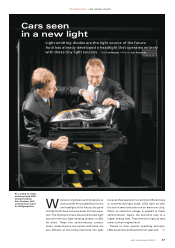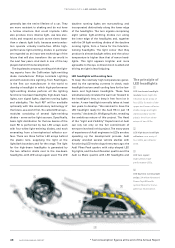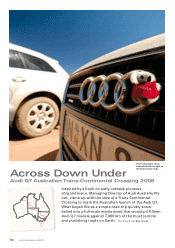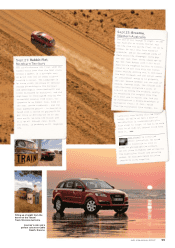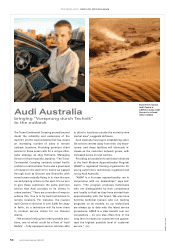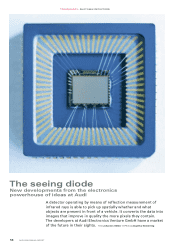Audi 2006 Annual Report Download - page 50
Download and view the complete annual report
Please find page 50 of the 2006 Audi annual report below. You can navigate through the pages in the report by either clicking on the pages listed below, or by using the keyword search tool below to find specific information within the annual report.
The principle of
LED headlights
LED low-beam headlight
module: basic light dis-
tribution by an array of
four LEDs for each of the
upper and lower reflector
shells, range and light/
dark boundary via the
plastic lens from three
arrays of two LEDs.
LED high-beam headlight
reflectors: one array of
four LEDs per reflector
shell.
LED turn signal:
eight yellow high-
performance LEDs.
LED daytime running light
strips: 24 white Advanced
Power TopLEDs with
optical fibres for homo-
geneous illumination.
4
3
2
1
1
4
2
3
TECHNOLOGY: LED HEADLIGHTS
48 AUDI 2006 ANNUAL REPORT
generally last the entire lifetime of a car. They
are more resistant to shaking and do not have
a hollow structure that could implode. LEDs
also produce more intense light, use less elec-
tricity and respond as much as ten times faster
than a classic light bulb, because semiconduc-
tors operate virtually inertia-free. White high-
performance light-emitting diodes in particular
are regarded as an important technology of the
future that will also transform the car world in
the next few years. And Audi is one of the key
players behind this development.
The Ingolstadt company, working with the light-
ing
experts from the Californian light-emitting
diode manufacturer Philips Lumileds Lighting
and with Automotive Lighting, from Reutlingen,
is the first car manufacturer in the world to
develop a headlight in which high-performance
light-emitting diodes perform all the lighting
functions: low-beam headlights, high-beam head
-
lights, turn signal lights, daytime running lights
and sidelights. The Audi R8* will be available
optionally with this revolutionary technology of
the future, as a world first. So-called LED arrays –
modules consisting of several light-emitting
diodes – serve as the light sources. Specifically,
basic light distribution for the low beams of the
Audi R8 is performed by two LED arrays each
with four white light-emitting diodes, and each
emanating from a hemispherical reflector sur-
face. There are three further LED arrays behind
the plastic lens, supplying the light at the
light/dark boundary and for the range. The light
for the high-beam headlights is generated by
the two reflector shells next to the low-beam
headlights, with LED arrays again used. The LED
daytime running lights are eye-catching, and
incorporated distinctively along the lower edge
of the headlights. The turn signals comprising
eight yellow light-emitting diodes run along
the inner edge of the headlights and, together
with the 24 light-emitting diodes of the daytime
running lights, form a frame for the futuristic-
looking headlights. The light colour that they
produce is almost daylight white, and the colour
temperature is higher than that of xenon head-
lights. This light appears brighter and more
agreeable to the eye, contrast vision is aided and
driving at night is less fatiguing.
LED headlights with cooling fans
To keep the relatively high temperatures gener-
ated by the operating currents in check, each
headlight has two small cooling fans for the low-
beam and high-beam headlights. These fans
simultaneously circulate the warm air forward to
the headlight’s lens, to keep it free from ice in
winter. A new headlight normally takes at least
two years to develop. “We resolved to have the
LED headlight ready for the Audi R8 in just 18
months,” declares Dr. Wolfgang Huhn, revealing
the ambitious nature of this project. The Head
of the “Light and Visibility” Department at Audi
can rely not only on the full commitment of
everyone involved in this project. The many years
of experience of Audi engineers in LEDs are also
speeding up the development process. Audi
already unveiled several vehicle studies with
functioning LED technology three years ago: the
Audi Pikes Peak quattro with strip-shaped LED
fog lights, and the Audi Nuvolari quattro and the
Audi Le Mans quattro with LED headlights and
* fuel consumption figures at the end of the Annual Report


